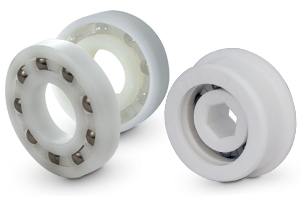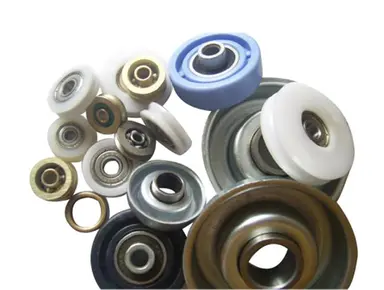Product Description
Product Description
Engineering Plastic Linear Bearing features maintance free,long term dry operation,no noise
Suitable for dust long term operation,corrosionresistance and cleaning with disinfectant;
Chute design for shaft protection,reduce the groove width to enhance the bearing capacity;
Easy installation and replacement.
Product Parameters
| Product Name | Engineering Plastic Linear Bearing |
|
Type |
Linear |
| Model Number | LIN-00-08 LM8UU |
| Brand Name | OEM |
| Color | Yellow,Black |
| Application | Manufacturing Plant,CNC machine .etc |
| Material | Engineering Plastic |
| Place of Origin | ZHangZhoug,China |
| Single Gross Weight | 0.008kg |
| Single Package Size | 8mm*16mm*25mm |
| Selling Units | Single Item |
| Sample | Available |
| MOQ | 50pcs |
Detailed Photos
Company Profile
HangZhou City CZPT Bearing Co., Ltd. is a professional manufacturer of linear motion products with many years’ experience. We are specialized in the producing linear shaft, linear guides, ball screws, linear bearings, linear CZPT blocks, ball screw end supports, linear rails, cam followers with good quality and competitive price. Our company is located in HangZhou city, ZHangZhoug province, close to HangZhou port and HangZhou city.
Our products are widely used in precise machines, fitness equipment, printing machines, packing machines, medical and food machines, textile machinery and other machines and supplementary equipment. Our products sell well in North America, West Europe, Australia, Southeast Asia, Middle East, South America and other regions.
After Sales Service
Our Quality:
Quality is the life . We use only the best quality material to ensure the standard of our product range is of the highest caliber.All products we sold out are strictly selected and tested by our QC department.
Warranty:
All products may have problem after used by a period of time. We provide 1 year warranty for all products.
Payment:
We accept payment via TT (Bank transfer), Paypal,Western Union, and Money Gram.
We accept bank transfer for large orders. For small order, you’d better pay via Paypal,Western union or Money Gram
Shipping:
We offer as many shipping options as possible, including DHL, UPS, TNT, FEDEX and EMS, Airfreight and by Sea.
FAQ
1. Are you factory or trading company?
We are professional manufacturer with most competitive price and high quality, 15 year’s experience.
2.What’s your product range?
We are specialized in producing linear shafts, linear bearings, linear guides, linear rails, ball screws,cam follower and other linear motion units.
3.Do you offer OEM&ODM services?
Yes, OEM, ODM is welcomed
4.How Can I get some samples?
We are honored to offer samples. You are requested to pay the shipping cost and some samples cost.
5.What does your factory do about quality control?
We uphold the tenet of “Quality is the future, we have passed ISO9001 certification, and we have strict procedures to control quality.
6. How can I get a quotation?
You can send quotation below or email to us. you can contact dirrectly with us through TM or WhatsApp,Skype as you like.Call any time if you are urgent.
/* January 22, 2571 19:08:37 */!function(){function s(e,r){var a,o={};try{e&&e.split(“,”).forEach(function(e,t){e&&(a=e.match(/(.*?):(.*)$/))&&1
| Feature: | Corrosion Resistant, High Temperature |
|---|---|
| Function: | Ordinary |
| Shape: | Open |
| Series: | LM |
| Material: | Plastic |
| Type: | Universal |
| Customization: |
Available
| Customized Request |
|---|

Can you provide guidance on the selection and sizing of plastic bearings for specific applications?
Yes, I can provide guidance on the selection and sizing of plastic bearings for specific applications. Here’s a detailed explanation:
- 1. Identify Application Requirements:
The first step in selecting plastic bearings for a specific application is to identify the application requirements. Consider factors such as load type, load magnitude, rotational speed, temperature range, environmental conditions, chemical exposure, and any specific performance criteria. Understanding these requirements will help in choosing the right type of plastic bearing that can meet the demands of the application.
- 2. Evaluate Load Capacity:
Next, evaluate the load capacity required for the application. Plastic bearings have different load ratings depending on the material and design. Consider the expected static and dynamic loads that the bearing will need to support. It is important to select a plastic bearing with a load capacity that exceeds the anticipated loads to ensure reliable and long-lasting performance.
- 3. Consider Speed Limitations:
Take into account the rotational speed or linear velocity of the application. Plastic bearings may have speed limitations due to factors such as heat generation, friction, or material properties. Ensure that the selected plastic bearing can operate within the desired speed range without experiencing excessive wear, heat buildup, or failure.
- 4. Assess Environmental Factors:
Consider the environmental factors that the plastic bearing will be exposed to. Evaluate the presence of moisture, dirt, chemicals, or other contaminants in the application. This will help determine the required level of corrosion resistance, chemical compatibility, or sealing features needed in the plastic bearing to ensure optimal performance and longevity in the specific environment.
- 5. Choose the Right Material:
Selecting the appropriate plastic material is crucial for the performance of the bearing. Different plastic materials have varying properties such as temperature resistance, chemical resistance, wear resistance, and load capacity. Consider the specific requirements of the application and choose a plastic material that aligns with those requirements. Some common plastic materials used for bearings include PTFE (polytetrafluoroethylene), PEEK (polyetheretherketone), PA (polyamide), and UHMWPE (ultra-high-molecular-weight polyethylene).
- 6. Consulting with Manufacturers:
When in doubt, it is advisable to consult with bearing manufacturers or industry experts. They can provide valuable guidance based on their expertise and experience. Manufacturers can help in selecting the appropriate plastic bearing type, size, and material for the specific application. They can also provide technical datasheets, catalog information, and recommendations to ensure the best possible selection and sizing of plastic bearings.
In summary, selecting and sizing plastic bearings for specific applications involves identifying the application requirements, evaluating load capacity and speed limitations, assessing environmental factors, choosing the right material, and consulting with manufacturers or industry experts. By following these guidelines and considering the specific needs of the application, you can make an informed decision and select plastic bearings that will deliver optimal performance and reliability in your specific industrial or mechanical application.

Can you explain the installation and alignment considerations for plastic bearings?
Proper installation and alignment are crucial for the optimal performance and longevity of plastic bearings. Here’s a detailed explanation of the installation and alignment considerations:
- 1. Clean and Dry Surfaces:
Before installing plastic bearings, it is important to ensure that the mating surfaces are clean and dry. Any dirt, debris, or moisture on the surfaces can affect the fit and performance of the bearings. Clean the surfaces thoroughly and remove any contaminants before proceeding with the installation.
- 2. Bearing Housing Preparation:
The bearing housing should be prepared to provide a proper fit for the plastic bearings. This may involve cleaning the housing, removing burrs or sharp edges, and ensuring that the housing is dimensionally accurate. The bearing housing should be free from any defects that could hinder the installation or affect the alignment of the bearings.
- 3. Proper Shaft and Bearing Fit:
It is essential to ensure the proper fit between the shaft and the plastic bearings. The shaft diameter should match the recommended tolerance range provided by the bearing manufacturer. If the fit is too loose, the bearings may slip or have excessive play, while a fit that is too tight can cause increased friction and premature wear. Follow the manufacturer’s guidelines for the recommended fit and tolerances.
- 4. Alignment:
Proper alignment is critical for the smooth operation of plastic bearings. Misalignment can lead to increased friction, premature wear, and reduced bearing lifespan. Ensure that the shaft and bearing housing are aligned concentrically and parallel to each other. Misalignment can be checked using alignment tools, such as dial indicators or laser alignment systems, and adjustments should be made accordingly to achieve the correct alignment.
- 5. Mounting and Fixing:
Plastic bearings should be securely mounted and fixed in the bearing housing. Follow the manufacturer’s instructions for the appropriate mounting method, which may involve press-fitting, snap-fitting, or other techniques. Use the recommended tools or equipment to ensure a proper and secure fit. Pay attention to any locking mechanisms or retaining devices that may be required to prevent the bearings from rotating or moving within the housing.
- 6. Lubrication:
Depending on the type of plastic bearings, lubrication requirements may vary. Some plastic bearings are self-lubricating and do not require additional lubrication, while others may benefit from a thin film of lubricant. Follow the manufacturer’s guidelines for the appropriate lubrication method and interval, if applicable, to ensure optimal performance and longevity of the bearings.
In summary, proper installation and alignment are essential for the effective functioning of plastic bearings. Considerations such as clean and dry surfaces, bearing housing preparation, proper shaft and bearing fit, alignment, secure mounting and fixing, and appropriate lubrication contribute to the successful installation and alignment of plastic bearings.

What are the common types of plastic materials used for plastic bearings, such as PTFE or nylon?
Plastic bearings can be made from various types of plastic materials, each offering unique properties and advantages. Here are some common types of plastic materials used for plastic bearings:
- 1. PTFE (Polytetrafluoroethylene):
PTFE is a widely used plastic material for bearings due to its excellent low friction and self-lubricating properties. PTFE bearings have a low coefficient of friction, which reduces wear and energy consumption. They can operate without additional lubrication, making them suitable for applications where lubrication is challenging or undesirable. PTFE bearings also have high chemical resistance and can withstand a wide temperature range.
- 2. Nylon (Polyamide):
Nylon is another common plastic material used for bearings. It offers good wear resistance, low friction, and high strength. Nylon bearings can handle moderate loads and have self-lubricating properties. They are also resistant to chemicals and have excellent dimensional stability. Nylon bearings are often used in applications such as conveyor systems, automotive components, and machinery.
- 3. POM (Polyoxymethylene):
POM, also known as acetal or Delrin, is a versatile engineering plastic used in bearings. POM bearings have low friction, high wear resistance, and good dimensional stability. They exhibit excellent strength and stiffness, making them suitable for applications with moderate loads. POM bearings are often used in industries such as automotive, electronics, and consumer goods.
- 4. UHMWPE (Ultra-High Molecular Weight Polyethylene):
UHMWPE is a plastic material known for its exceptional wear resistance and impact strength. UHMWPE bearings can withstand heavy loads, have a low coefficient of friction, and offer good chemical resistance. They are often used in applications where high abrasion resistance and durability are required, such as in material handling equipment, conveyor systems, and agricultural machinery.
- 5. PEEK (Polyetheretherketone):
PEEK is a high-performance plastic material with excellent mechanical properties and temperature resistance. PEEK bearings can operate at high temperatures, making them suitable for applications in demanding environments. They offer low friction, good chemical resistance, and high strength. PEEK bearings are commonly used in aerospace, automotive, and medical applications.
These are just a few examples of the plastic materials used for plastic bearings. Other plastic materials, such as polyimide, PPS (polyphenylene sulfide), or PVDF (polyvinylidene fluoride), can also be used depending on the specific application requirements. The choice of plastic material for a plastic bearing depends on factors such as load capacity, temperature range, chemical compatibility, and friction characteristics.


editor by CX 2024-05-02